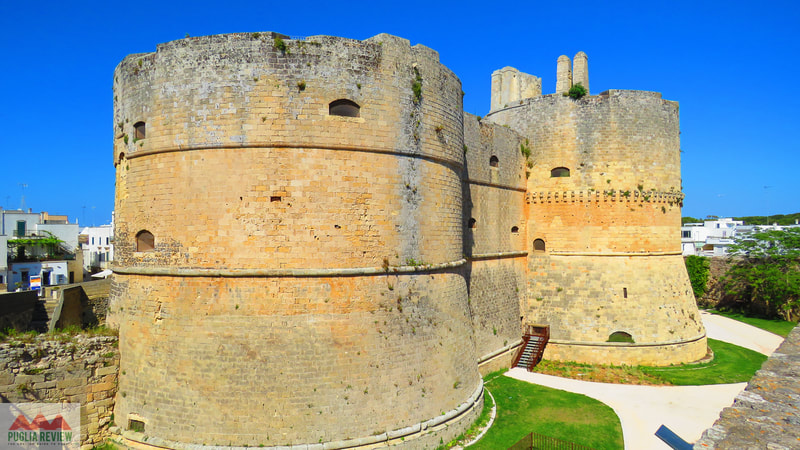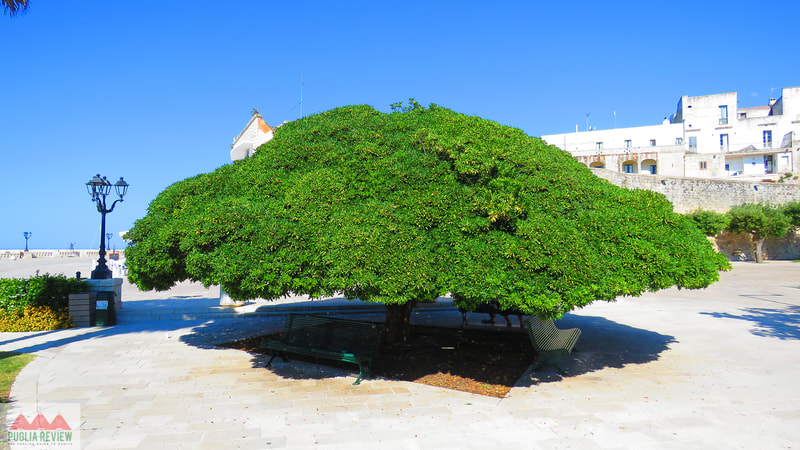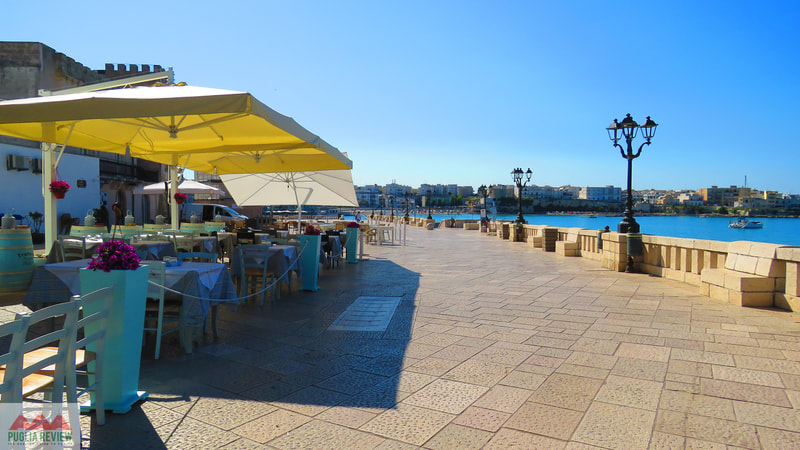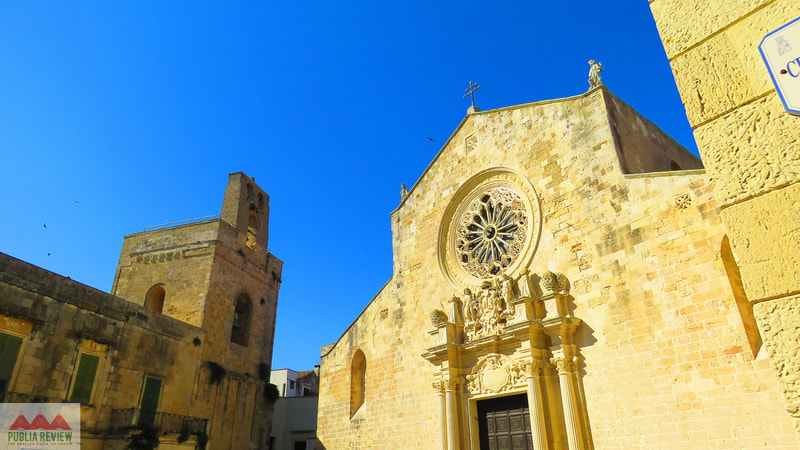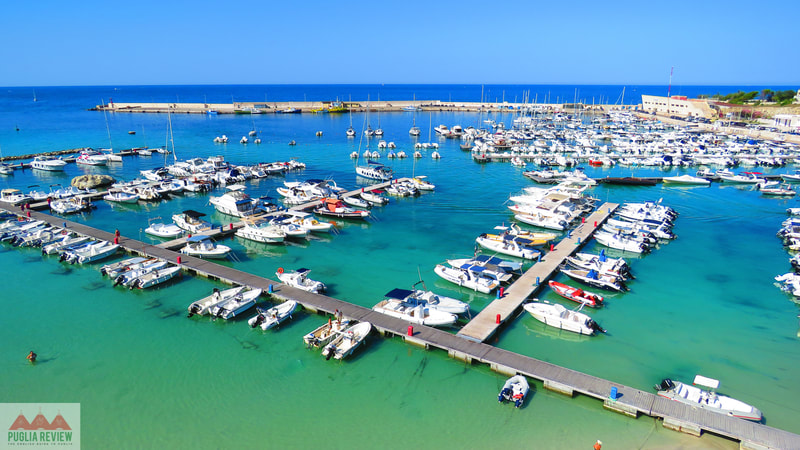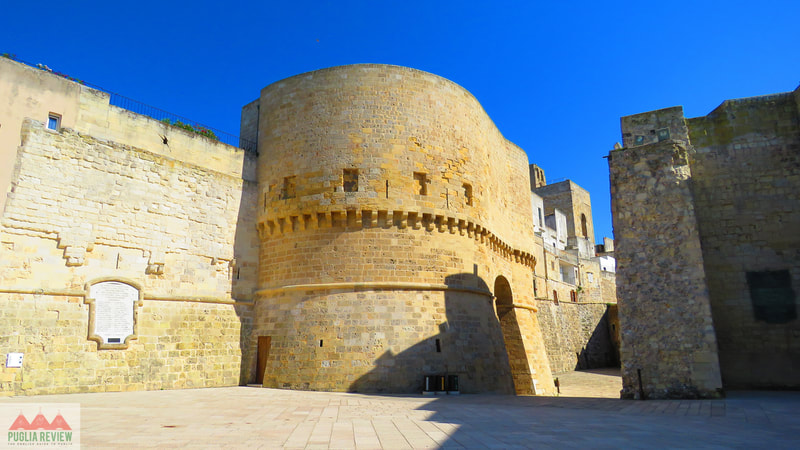Otranto
|
By Dion Protani
|
Latest update: 30 December 2023
|
|
At just about the easternmost point in Italy, the seaside resort of Otranto is the most important town along the Salento region's Ionian coast.
The word "Otranto" is used in the Italian phonetic alphabet to represent the letter O, and it's also important to stress that first O when pronouncing the town's name. One of Puglia's favourite holiday destinations, Otranto can offer crystalline waters around its town centre beaches and marina. |
Related links
A troubled history
However, it's to the past that one must first look when describing Otranto as its history has been the greatest influence on the present. A once important Roman trading post, taking advantage of its proximity to the Balkan Peninsula, Otranto has borne witness to high drama and the greatest of tragedies in the intervening years. Modern-day Albania is just a short distance across the sea from Otranto and can be seen on a clear day, but whilst this proved advantageous for trade, it also opened envious eyes to the possibility of rape and pillage, activities to which marauding Saracen pirates were only too happy to oblige.
At the fall of the Roman Empire, Otranto's rule was undertaken by the Byzantines who duly held it until the Normans came in the 11th century. The periods of Norman and Byzantine rule saw medieval Otranto flourish but all that was to change in 1480 when a Turkish invasion proved the catalyst for the town's darkest days. After a two week siege, the city eventually fell with a figure of some 12,000 of the town's defenders said to have perished during the fight. It's difficult to imagine how things could get worse, but worse they got.
At the fall of the Roman Empire, Otranto's rule was undertaken by the Byzantines who duly held it until the Normans came in the 11th century. The periods of Norman and Byzantine rule saw medieval Otranto flourish but all that was to change in 1480 when a Turkish invasion proved the catalyst for the town's darkest days. After a two week siege, the city eventually fell with a figure of some 12,000 of the town's defenders said to have perished during the fight. It's difficult to imagine how things could get worse, but worse they got.
Otranto's main sights
The Turks tried to convert the remaining 813 survivors to their faith but were refused. As a punishment, it is said that the town's leading clerical figure was sawn in half while still alive, and the other survivors were all marched up to a hill overlooking the town where they were subsequently beheaded. In what represents one of the most macabre visitor attractions in Italy, the bones of the town's martyrs are now on display in glass cases in Otranto Cathedral.
Somewhat more pleasing to the eye in the 11th century edifice is an incredible floor mosaic created by a monk called Pantaleone. The enormous mosaic which depicts a Tree of Life along with a mixture of heraldic and animal images, is considered one of the region's most important surviving pieces of work from the period.
Dominating the landscape of Otranto's centro storico (historic centre) is the Castello Aragonese. The castle was restored and strengthened by the ruling Spanish during the 16th century, creating an impressive and imposing stronghold to ward off further invasions such as that by the Turks in 1480 which had caused a great deal of damage. Nowadays you can visit various rooms in the castle or climb the ramparts to get some of the best views of the town.
Somewhat more pleasing to the eye in the 11th century edifice is an incredible floor mosaic created by a monk called Pantaleone. The enormous mosaic which depicts a Tree of Life along with a mixture of heraldic and animal images, is considered one of the region's most important surviving pieces of work from the period.
Dominating the landscape of Otranto's centro storico (historic centre) is the Castello Aragonese. The castle was restored and strengthened by the ruling Spanish during the 16th century, creating an impressive and imposing stronghold to ward off further invasions such as that by the Turks in 1480 which had caused a great deal of damage. Nowadays you can visit various rooms in the castle or climb the ramparts to get some of the best views of the town.
Down by the sea
Castello Aragonese is located at the south-east corner of the centro storico and this is a great place to start a walking itinerary of the town from. Cross the bridge from the castle across the dry moat and turn right, to eventually make your way round to the Torre Matta. The top of the tower offers another great vantage point for views and photos of the town, particularly its marina and port where the bright azure water glitters from above. From Torre Matta you can see the next place to go, down the steps to follow the steep sea wall and towards the town's main promenade, the Lungomare degli Eroi.
The Lungomare degli Eroi (promenade of heroes) is the real hub of the town; from here you can head towards the various beaches or take a walk towards the inner environs of the centro storico. Passing through the stone archway of the rounded Torre Alfonsina, you soon find yourself exploring the town's labyrinthine collection of narrow streets. From here you can make your way up to the Cathedral or just pass the time visiting the many shops, restaurants and bars of various types.
The Lungomare degli Eroi (promenade of heroes) is the real hub of the town; from here you can head towards the various beaches or take a walk towards the inner environs of the centro storico. Passing through the stone archway of the rounded Torre Alfonsina, you soon find yourself exploring the town's labyrinthine collection of narrow streets. From here you can make your way up to the Cathedral or just pass the time visiting the many shops, restaurants and bars of various types.
Travel and the surrounding area
Otranto has a train station located 10-15 minutes' walk west of the centro storico; trains from here run up to the inland town of Maglie from where you can then connect to Lecce and beyond. You can also reach Lecce by bus but the very best way to get the most out of the Salento area is by car.
Immediately south of Otranto is one of the most colourful and perhaps surprising sights in Puglia, the Mars-like landscape of Cava di Bauxite. That's the ideal first stop for a drive around the Salento's southern tip where you can find beautiful beaches like Porto Badisco and great seaside towns such as Castro and Santa Maria di Leuca to name just two. Head north and the highlights include the resorts of Torre dell'Orso and San Foca which is in turn just a stone's throw from the famous Grotta della Poesia.
Immediately south of Otranto is one of the most colourful and perhaps surprising sights in Puglia, the Mars-like landscape of Cava di Bauxite. That's the ideal first stop for a drive around the Salento's southern tip where you can find beautiful beaches like Porto Badisco and great seaside towns such as Castro and Santa Maria di Leuca to name just two. Head north and the highlights include the resorts of Torre dell'Orso and San Foca which is in turn just a stone's throw from the famous Grotta della Poesia.
Comune di Otranto
|
Province: Lecce
Region: Puglia Population: 5,715 (source: ISTAT 1 January 2023) Size: 77 km² Highlights: Castello Aragonese, Otranto Cathedral, Lungomare Water quality: Blue Flag Beach 2021 - 2022 Close by: Lecce, Gallipoli, Torre Sant'Andrea, Salento, Brindisi Recommended accommodation: Hotel Palazzo Papaleo |
One of I Borghi più belli d'Italia (Italy's Most Beautiful Villages)
Listing headline: Fascino d'Oriente (Eastern Charm)
Listing headline: Fascino d'Oriente (Eastern Charm)

